By Ralph Anker, Editor, anna.aero
Traffic at airports in Ireland and Northern Ireland is dominated these days by low-cost carriers (LCCs). Given that Ireland is the home of Europe’s biggest and most successful (though not necessarily most loved) LCC, Ryanair, a strong presence at the airports is not surprising but the gradual disappearance of British Airways and the limited operations of many mainland European flag carriers reveals how dominant LCCs have become in the region.
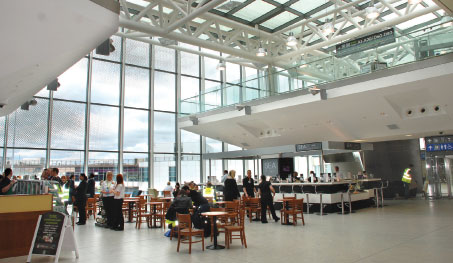
Work on the €1.2 billion Transforming Dublin Airport capital programme continues and will be completed over the next 18 months.
Apart from Ryanair, easyJet has a major presence in Belfast (though none in Ireland itself) while bmibaby and Jet2.com both serve several destinations, and Aer Lingus and Flybe, whose inclusion in a list of LCCs can be debated, both have a significant presence with Aer Lingus having even set up a base at Belfast International in December 2007.
Dublin dominates traffic figures
There are seven airports in Ireland and Northern Ireland that each handled more than a quarter of a million passengers in 2008, led by Dublin with 23.5 million. Dublin handled well over half of all passengers in the region last year, thanks to being the home base of both Aer Lingus and Ryanair. Total traffic in 2008 and the recent passenger trends are summarised below.
Ireland also has a handful of other smaller airports which offer limited scheduled services. These include Donegal, Galway, Kerry, Sligo and Waterford.
Dublin’s growth in recent years has been driven by the increase in non-stop services to mainland Europe. In 1998 passengers to Great Britain represented 59% of Dublin’s traffic, which was then just 11.6 million. Nine years later traffic had doubled to 23.3 million and Great British traffic represented just 37% of the total. Traffic to Europe had more than trebled from 3.4 million passengers to 12.1 million during the same period. As a result mainland European traffic now represents over half of Dublin’s total. During this boom period for Dublin, transatlantic traffic has consistently represented between 6% and 7% of the total.
| Airport | 2008 pax | Jan-09 | Feb-09 | Mar-09 | Apr-09 |
| Dublin | 23.47m | -7.90% | -11.90% | -13.90% | -4.50% |
| Belfast International | 5.22m | -10.50% | -14.70% | -21.00% | -1.80% |
| Cork | 3.26m | -13.00% | -16.40% | -18.40% | -13.00% |
| Shannon | 3.17m | -1.70% | 4.50% | -6.00% | -7.00% |
| Belfast City | 2.57m | -6.90% | -11.10% | -7.50% | 1.70% |
| Knock | 0.63m | -2.60% | -17.90% | -20.60% | -2.90% |
| City of Derry | 0.44m | -31.60% | -31.10% | -36.20% | -25.00% |
| Source: UK CAA, DAA, Ireland West Airport Knock | |||||
Irish travel tax impact yet to be quantified
Passenger numbers in 2009 have fallen at all airports (except Shannon in February) and although April figures may look more encouraging thanks to the re-timing of Easter it was also the first month of the implementation of the €10 departure tax introduced at all Irish airports (except Donegal and Sligo). For flights under 300 kilometres (such as Dublin to Liverpool and Manchester for example) the tax is reduced to just €2. Not surprisingly, Ryanair with its very low average fares has been extremely vocal about this decision. By contrast Aer Lingus (still majority owned by the government remember) has made no mention of the decision in any of its recent investor relations material. With the abolition in recent years of similar charges in Belgium, Denmark and the Netherlands, it will be interesting to see what impact this additional cost has on tourist numbers, which play such a vital part in sustaining what is currently a faltering Irish economy.
Long-haul focus on US routes
Long-haul routes at Irish airports are dominated by flights to and from the US. Apart from Aer Lingus which currently operates six non-stop routes from Dublin and three from Shannon, four of the major US carriers are also present. Continental serves Dublin, Shannon (and Belfast) from Newark, while Delta operates to Dublin from Atlanta and New York and to Shannon from New York. American and US Airways also operate daily flights to Dublin. Other long-haul services to the east are rather rarer though Etihad operates daily from Abu Dhabi.
Belfast served by two airports
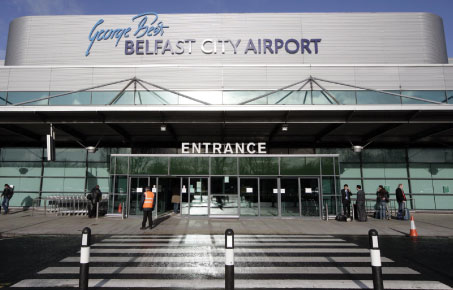
George Best Belfast City Airport, located just two kilometres from downtown Belfast, is this year celebrating its 25th anniversary and has plans to extend its runway length by 590 metres to just over 2,400 metres.
Belfast must be one of the smallest cities in Europe to be served by two airports, each of which handles over one million passengers per annum. Belfast International at Aldergrove is the bigger airport and has the longer runway, though it is further from the city centre than Belfast City airport (which since 2006 has marketed itself as George Best Belfast City Airport in honour of the legendary Manchester United footballer). This year the airport, located just two kilometres from downtown Belfast, is celebrating its 25th anniversary and has plans to extend its runway length by 590 metres to just over 2,400 metres.
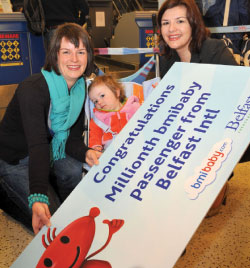
In May, bmibaby celebrated its millionth passenger from Belfast International. The airline operates seven flights to four UK destinations from the airport.
Ryanair set up a base at the airport in October 2007 but its longest route is only to London Stansted and the airline is currently handicapped operationally by the 1,800 metre runway. Flybe is currently the busiest airline at the airport serving 16 UK destinations, many with multiple daily flights. At Belfast International Aer Lingus and easyJet compete head-to-head on various routes, while bmibaby, Flyglobespan, Jet2.com and Thomson mean that almost all of the airport’s scheduled services are on low-cost airlines. The exception is the previously mentioned Continental service to Newark.
Ryanair and Aer Lingus dominate services; no British Airways
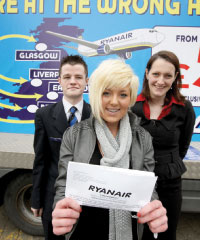
Analysis of all current scheduled services at the seven major airports in the region reveals that Ryanair and Aer Lingus between them account for around 70% of all seat capacity. Ryanair launched a new route to Bristol in March and took to the streets at the end of March to give out free flights for the new route.
Analysis of all current scheduled services at the seven major airports in the region reveals that Ryanair and Aer Lingus between them account for around 70% of all seat capacity, with easyJet ranked third with 7.4% thanks to its 17 routes from Belfast. Nine of these routes are to mainland Europe while eight are to Great Britain. Flybe operates more flights than easyJet but offers fewer seats on its 16 Belfast City routes and two from Dublin (to Exeter and Southampton).
The leading mainland European airline is Air France with three routes, though these are all operated by Air France-owned, Dublin-based CityJet using four-engined Avro RJ85s. Lufthansa and SAS both serve Dublin from their major hubs. European-based LCCs are currently limited to Germanwings (serving Dublin from Cologne/Bonn) and Wizz Air, which operates four routes from Cork to Poland, all at less than daily frequency. Perhaps the biggest shock is that British Airways no longer operates any flights to Ireland or Northern Ireland. At the beginning of March this year it axed its ‘CityFlyer’ service from London City to Dublin, thus ending its presence in the region.
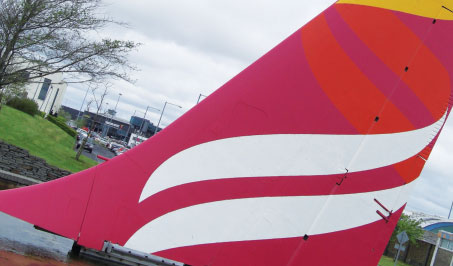
A monument at Shannon Airport commemorating 50 years of transatlantic flights at the airport (in 1995).
Read more about new airline routes at anna.aero.







